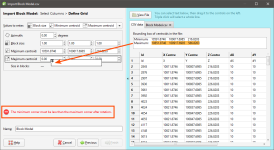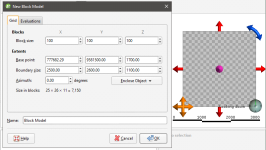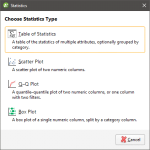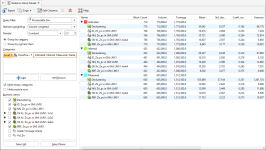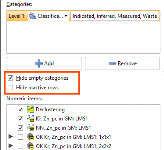Block Models
The Block Models folder can be used to import and create block models. Model types that can be imported are:
- Isatis files
- CSV files
You can also create block models and sub-blocked models, which can then be exported for use in other applications. Creating block models within Leapfrog Geo has the advantage that the resolution can easily be changed.
Geological models and interpolants can be evaluated on block models as described in Evaluations. If you have the Leapfrog Edge extension, estimators can also be evaluated on block models. If you have the Hydrogeology extension, flow models can also be evaluated on block models.
The rest of this topic describes importing block models in Isatis and CSV formats, creating block models in Leapfrog Geo, viewing block model statistics and exporting block models. It is divided into:
- Importing a Block Model
- Creating a Block Model
- Displaying a Block Model
- Viewing Block Model Statistics
- Exporting Block Models
Importing a Block Model
Leapfrog Geo imports block models in the following formats:
- CSV + Text Header (*.csv, *.csv.txt)
- CSV with Embedded Header (*.csv)
- Isatis Block Model Files (*.asc)
Note that neither CSV format requires a header; once you start the import process, Leapfrog Geo will use the data in the file to locate the minimum and maximum centroids. You can view this information and change how the data is mapped before the file is saved into the project.
Importing an Isatis Block Model
To import an Isatis format block model, right-click on the Block Models folder and select Import Block Model. Select the file you wish to import and click Open. The model will be imported and added to the Block Models folder.
Importing a Block Model in CSV Format
Block models imported in CSV format must be regular, rotated only about the Z axis. You will also need to map the data in the file to the block model format Leapfrog Geo expects.
To import a block model in CSV format, right-click on the Block Models folder and select Import Block Model. Select the file you wish to import and click Open. An import window will be displayed in which you can map the columns in the file to those Leapfrog Geo expects. Once you have mapped the required columns, click Next to define the grid.
In the next window, Leapfrog Geo uses the data in the file to check the grid definition and confirm that the centroids match:
If this information is incorrect, you can select information in the file and drag it to the corresponding values on the left-hand side:
The easiest way to define the blocks is to use the Block size, Minimum centroid, Maximum centroid option. You can also enter the grid definition values manually.
Once Leapfrog Geo has validated the grid definition, click Finish. The block model will be imported and will appear in the Block Models folder.
Creating a Block Model
To create a new block model, right-click on the Block Models folder and select New Block Model. The New Block Model window will appear, together with a set of controls that will help you set the size, location and orientation of the model in the scene:
The block model is defined from its Base point, and the reference centroid is the Base point plus one half the Block size. Block models cannot have partial blocks, and when changes are made to the Block size parameter, the model’s extents will be enlarged to match the Block size.
If you know the values you wish to use for the model’s Extents, enter them in New Block Model window. You can also:
- Use the controls in the scene to set the extents.
- The orange handle sets the Base point.
- The red handles adjusts the size of the boundary.
- The blue handle adjusts the Azimuth.
- Use another object’s extents. Select the object from the Enclose Object list.
If you wish to define a tilted block model, create a sub-blocked model with no triggers. See Sub-Blocked Models.
It is a good idea to use larger values for the Block size as processing time for large models can be considerable. Once you have created a block model, you can change its properties to provide more detail.
You can also evaluate the block model against geological models, interpolants and distance functions in the project. To do this, click on the Evaluations tab. All objects available in the project will be displayed. Move the models you wish to use into the Selected list.
Enter a Name for the block model and click OK. The model will appear under the Block Models folder. You can make changes to it by double-clicking on it.
Displaying a Block Model
When a block model is displayed in the scene, there is an Index Filter option for displaying the grid:
For None, no X, Y or Z filter is applied. For Subset, the grid is filtered to show the union of the selected X, Y and Z ranges. For Sliced, the grid is filtered to show the intersection of the selected X, Y and Z ranges.
For the Subset and Sliced options, tick the boxes for X, Y and Z. To adjust the range, drag the white handles left and right. Double-clicking on the slider alternates between displaying a single value and displaying the full range.
Viewing Block Model Statistics
To view statistics on a block model, right-click on the model in the project tree and select Statistics. The following options are available:
See the Analysing Data topic for more information on each option:
Right-clicking a block model evaluation or a numeric calculation and selecting Statistics opens a univariate graph for the selection. See Univariate Graphs in the Analysing Data topic for more information.
Table of Statistics
You can view statistics for all evaluations and calculations made on a block model broken down into categories and organised by numeric evaluations and calculations. To view statistics, right-click on a block model in the project tree, select Statistics then select the Table of Statistics option.
You can view statistics for as many numeric and category columns as you wish. When you have at least one Category column selected, you can organise the information displayed in two ways: Group by Category or Group by Numeric. Here, statistics are displayed organised by the category data columns:
The Query filter option uses a related filter to constrain the data set to a selected subset.
Statistics can be unweighted, weighted by volume or weighted by tonnage. Select the option you require from the Statistics weighting list.
You can also set the Density to be a Constant value that you specify, or you can use the one of the columns in the table.
The Categories list provides category classification options. When selected, the set of statistics measures for each evaluation or numeric calculation will be shown for each category.
You can hide empty categories (those with a count of zero) and inactive rows using the options below the Categories list:
Group by category and Group by numeric column provide options for the table organisation.
Other controls in this window are as follows:
- The arrow buttons at the top of the window (
 and
and  ) allow you to quickly expand or collapse the rows.
) allow you to quickly expand or collapse the rows. - Click rows to select them.
- Select multiple rows by holding down the Shift or Ctrl key while clicking rows.
- The Copy button (
 ) copies the selected rows to the clipboard so you can paste them into another application.
) copies the selected rows to the clipboard so you can paste them into another application.
Exporting Block Models
Block models created in Leapfrog Geo can be exported in the following formats:
- CSV + Text Header (*.csv, *.csv.txt)
- CSV with Embedded Header (*.csv)
- CSV as points (*.csv)
- Isatis Block Model Files (*.asc)
- Surpac Block Model Files (*.mdl)
- Datamine Block Model Files (*.dm)
To export a block model, right-click on the block model in the project tree and select Export. You will be prompted to select the file format.
If you wish to export the model in one of the CSV formats, select CSV Block Model Files (*.csv) in the Export Block Model window. You will be able to choose between the three CSV formats in the next step.
Enter a name and location for the file and click Save. Next, you will be able to choose custom settings for the selected format.
The rest of this topic provides more information about exporting block models in CSV, Isatis, Datamine and Surpac formats.
- Exporting Block Models in CSV Format
- Exporting Block Models in Isatis Format
- Exporting Block Models in Datamine Format
- Exporting Block Models in Surpac Format
Exporting Block Models in CSV Format
The selections you make when you export a block model will be saved. This streamlines the process of subsequent exports of the model.
When you choose to export a block model in CSV format, you must first choose the type of CSV export. Options are:
- With an embedded header file. The block model definition is included at the top of the CSV file.
- With a separate text header. The block model definition is written as a separate text file.
- As points. The CSV file does not include the block sizes and model description.
Click Next. The steps that follow are:
- Selecting From Evaluated Items
- Setting Row Filtering Options
- Setting Numeric Precision
- Setting Status Code Text Sequences
- Selecting the Character Set
Selecting From Evaluated Items
Choose which objects will be included in the exported file. The Available items list includes all evaluations made onto the model. If you have the Leapfrog Edge extension, you can also include calculations and filters, which will be exported as separate columns. The order of columns in the exported file will match the order shown in the project tree.
Click Next.
Setting Row Filtering Options
If you have the Leapfrog Edge extension, you can use a Query filter to filter rows out of the data exported.
This is different from exporting filters as columns, as selected in the previous step.
Click Next.
Setting Numeric Precision
There are three encoding options for Numeric Precision:
- The Double, floating point option provides precision of 15 to 17 significant decimal places.
- The Single, floating point option provides precision of 6 to 9 significant decimal places.
- The Custom option lets you set a specific number of decimal places.
To change either the Centroid and size precision and Column data precision options, untick the box for Use default precision and select the required option.
Click Next.
Setting Status Code Text Sequences
When a block model is exported, non-Normal status codes can be represented in the exported file using custom text sequences.
The Status Code sequences are used for category status codes and filter status codes exported as columns. For filter status codes, Boolean value results will show FALSE and TRUE for Normal values or the defined Status Codes for non-Normal values.
Boolean values on block models are only available if you have the Leapfrog Edge extension.
Numeric Status Codes can be represented using custom text sequences. This is optional; if no separate codes are defined for numeric items, the defined Status Codes will be used.
Click Next.
Selecting the Character Set
The selection you make will depend on the target for your exported file. You can choose a character set and see what changes will be made.
Click Next to view a summary of the selected options, then click Export to save the file.
Exporting Block Models in Isatis Format
The selections you make when you export a block model will be saved. This streamlines the process of subsequent exports of the model.
When exporting a block model in Isatis format, the steps to follow are:
Selecting From Evaluated Items
Choose which objects will be included in the exported file. The Available items list includes all evaluations made onto the model. If you have the Leapfrog Edge extension, you can also include calculations and filters, which will be exported as separate columns. The order of columns in the exported file will match the order shown in the project tree.
Click Next.
Setting Status Code Text Sequences
When a block model is exported, non-Normal status codes can be represented in the exported file using custom text sequences.
When exporting block models in Isatis format, both category and numeric status codes can use independent custom text sequences. For filter status codes, Boolean values are exported using 0 for false and 1 for true; non-Normal values will be left blank and status codes cannot be distinguished.
Boolean Status Codes on block models are only available if you have the Leapfrog Edge extension.
Click Next.
Selecting the Character Set
The selection you make will depend on the target for your exported file. You can choose a character set and see what changes will be made.
Click Next to view a summary of the selected options, then click Export to save the file.
Exporting Block Models in Datamine Format
The selections you make when you export a block model will be saved. This streamlines the process of subsequent exports of the model.
When exporting a block model in Datamine format, the steps to follow are:
- Selecting From Evaluated Items
- Setting Row Filtering Options
- Setting Status Code Text Sequences
- Selecting the Character Set
- Renaming Items
Selecting From Evaluated Items
Choose which objects will be included in the exported file. The Available items list includes all evaluations made onto the model. If you have the Leapfrog Edge extension, you can also include calculations and filters, which will be exported as separate columns. The order of columns in the exported file will match the order shown in the project tree.
Click Next.
Setting Row Filtering Options
If you have the Leapfrog Edge extension, you can use a Query filter to filter rows out of the data exported.
This is different from exporting filters as columns, as selected in the previous step.
Click Next.
Setting Status Code Text Sequences
When a block model is exported, non-Normal status codes can be represented in the exported file using custom text sequences.
When exporting block models in Datamine format, both category and numeric status codes can use independent custom text sequences. Boolean values are exported using values 0 for false and 1 for true; specify if non-Normal values should be represented by 0 or by the numeric status codes.
Boolean Status Codes on block models are only available if you have the Leapfrog Edge extension.
Click Next.
Selecting the Character Set
The selection you make will depend on the target for your exported file. You can choose a character set and see what changes will be made.
Click Next.
Renaming Items
When exporting a block model in Datamine format, column names for the evaluated objects have a maximum length of 8 characters. Leapfrog Geo will recommend truncated column names, but if you wish to use different abbreviations, click on the item’s New Name to edit it.
Click Next to view a summary of the selected options, then click Export to save the file.
Exporting Block Models in Surpac Format
The selections you make when you export a block model will be saved. This streamlines the process of subsequent exports of the model.
When you choose to export a block model in Surpac format, you must first choose whether to export the model in Surpac version 3.2 or Surpac version 5.0. Considerations are as follows:
- Block models exported in Surpac version 5.0 cannot be imported into versions of Surpac before 5.0.
- Block models with more than 512 blocks per side can only be exported in Surpac version 5.0 format.
Choose which format you wish to use.
Click Next. The steps that follow are:
- Selecting From Evaluated Items
- Setting Row Filtering Options
- Setting Numeric Precision
- Setting Status Code Text Sequences
- Selecting the Character Set
Selecting From Evaluated Items
Choose which objects will be included in the exported file. The Available items list includes all evaluations made onto the model. If you have the Leapfrog Edge extension, you can also include calculations and filters, which will be exported as separate columns. The order of columns in the exported file will match the order shown in the project tree.
Click Next.
Setting Row Filtering Options
If you have the Leapfrog Edge extension, you can use a Query filter to filter rows out of the data exported.
This is different from exporting filters as columns, as selected in the previous step.
Click Next.
Setting Numeric Precision
There are two encoding options for Numeric Precision:
- The Double, floating point option provides precision of 15 to 17 significant decimal places.
- The Single, floating point option provides precision of 6 to 9 significant decimal places.
To use one of these options, untick the box for Use default precision and select the required option.
If you are exporting the model in Surpac version 5.0, you can change the Display precision used for the Double, floating point and Single, floating point options.
Click Next.
Setting Status Code Text Sequences
When exporting block models in Surpac format, non-Normal category and numeric status codes can be represented in the exported file using custom text sequences. Status codes cannot be used for Boolean values; non-Normal values are set to false.
Click Next.
Selecting the Character Set
The selection you make will depend on the target for your exported file. You can choose a character set and see what changes will be made.
Click Next to view a summary of the selected options, then click Export to save the file.
Got a question? Visit the Seequent forums or Seequent support

